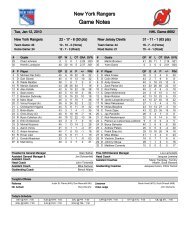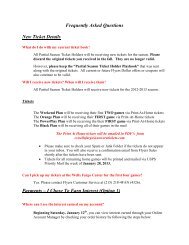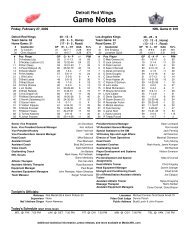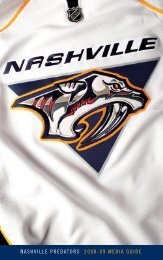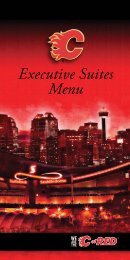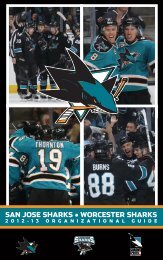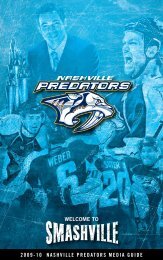Levitt Report - NHL.com
Levitt Report - NHL.com
Levitt Report - NHL.com
Create successful ePaper yourself
Turn your PDF publications into a flip-book with our unique Google optimized e-Paper software.
Background:Twenty-two of the 30 <strong>NHL</strong> teams play in an arena that is 50% or more owned,operated or controlled by the team or an affiliated or related-party. Some of these22 teams share the arena with an NBA basketball team and all of the arenas inwhich these teams play host other non-hockey events such as college basketballand concerts. As a result, these arenas and teams often generate revenues andincur expenses that relate to both hockey and non-hockey activities. In theseinstances and for URO purposes, teams must determine the amount of revenuesand expenses that are associated with operating a professional hockey franchise inthe <strong>NHL</strong> and those amounts of revenues and expenses that are derived from nonhockeyactivities.Because of the individualized nature of the relationships between each team andits affiliated or related parties, and because each team faces differentcircumstances and market conditions, the URO does not mandate a uniformmethodology of allocating revenues and expenses received by affiliated or relatedparties between hockey and non-hockey activities. The instructions in the 2002-03 URO provide that:“Activities relating to <strong>NHL</strong> hockey which are carried on through a parent<strong>com</strong>pany, a subsidiary <strong>com</strong>pany, a sister <strong>com</strong>pany or through any otherentity which shares <strong>com</strong>mon or family operating control with the Teamare considered “Affiliated” and <strong>NHL</strong> hockey’s share of those operationsmust be reflected herein. . . . The method of revenue/cost allocationbetween hockey and non-hockey may vary from one Club to anotherdepending on the significance of the events held in your building. In allcases, when revenues/costs are being allocated, the Club should follow thefollowing general principles:(a)(b)(c)The basis of allocation should be based on management’s bestestimate of the economic reality of the transaction(s) andreflect a reasonable approach to allocation.The basis of allocation should be consistent to the basis used toreport prior years unless the analysis in (a) requires change.Where appropriate, the basis should be consistent to internaland external reporting.”The URO instructions also provide that, to the extent any team revenues orexpenses were based on allocations between hockey and non-hockey activities,the team must provide detailed supporting schedules explaining the calculationsand the principles underlying the allocations.In our review of the financial information provided by the 22 teams that play in anarena that is 50% or more owned or operated or controlled by the team, or anaffiliated or related-party, we observed a wide diversity of practices in how theseteams allocate certain arena revenues and expenses, such as those related to fees12



